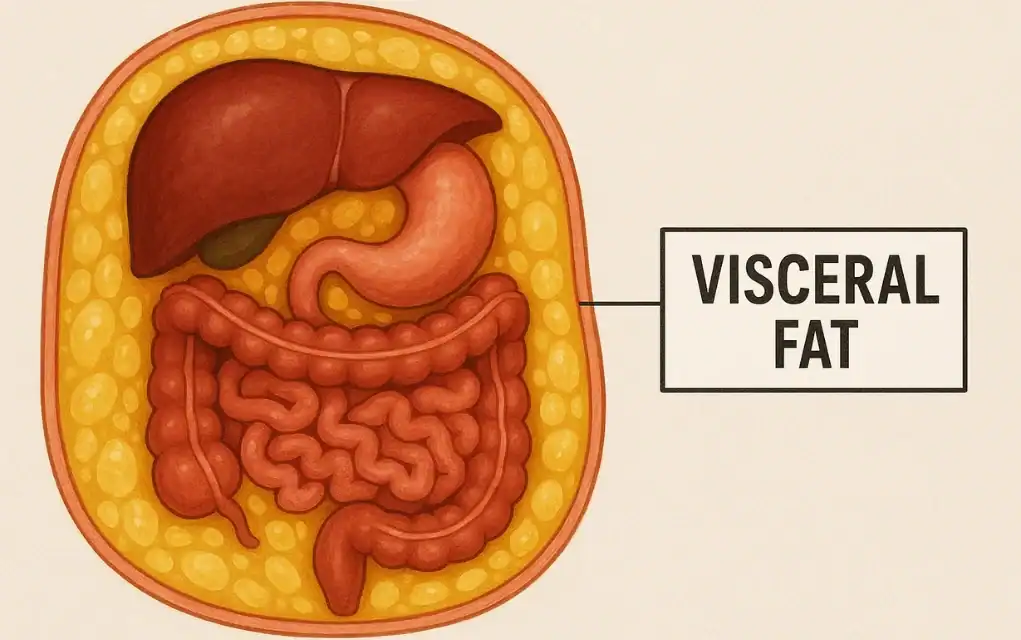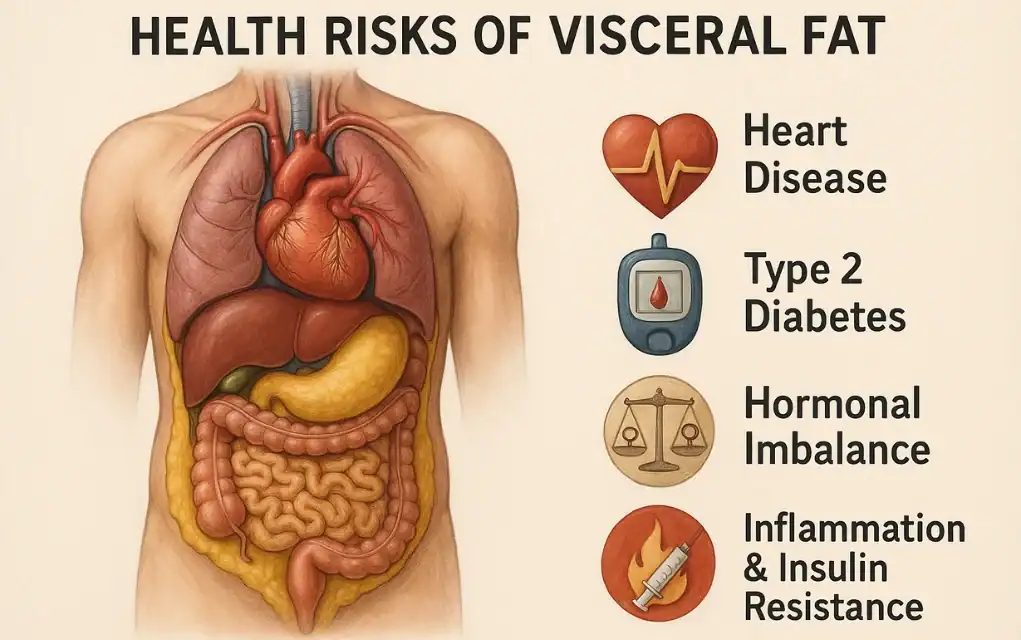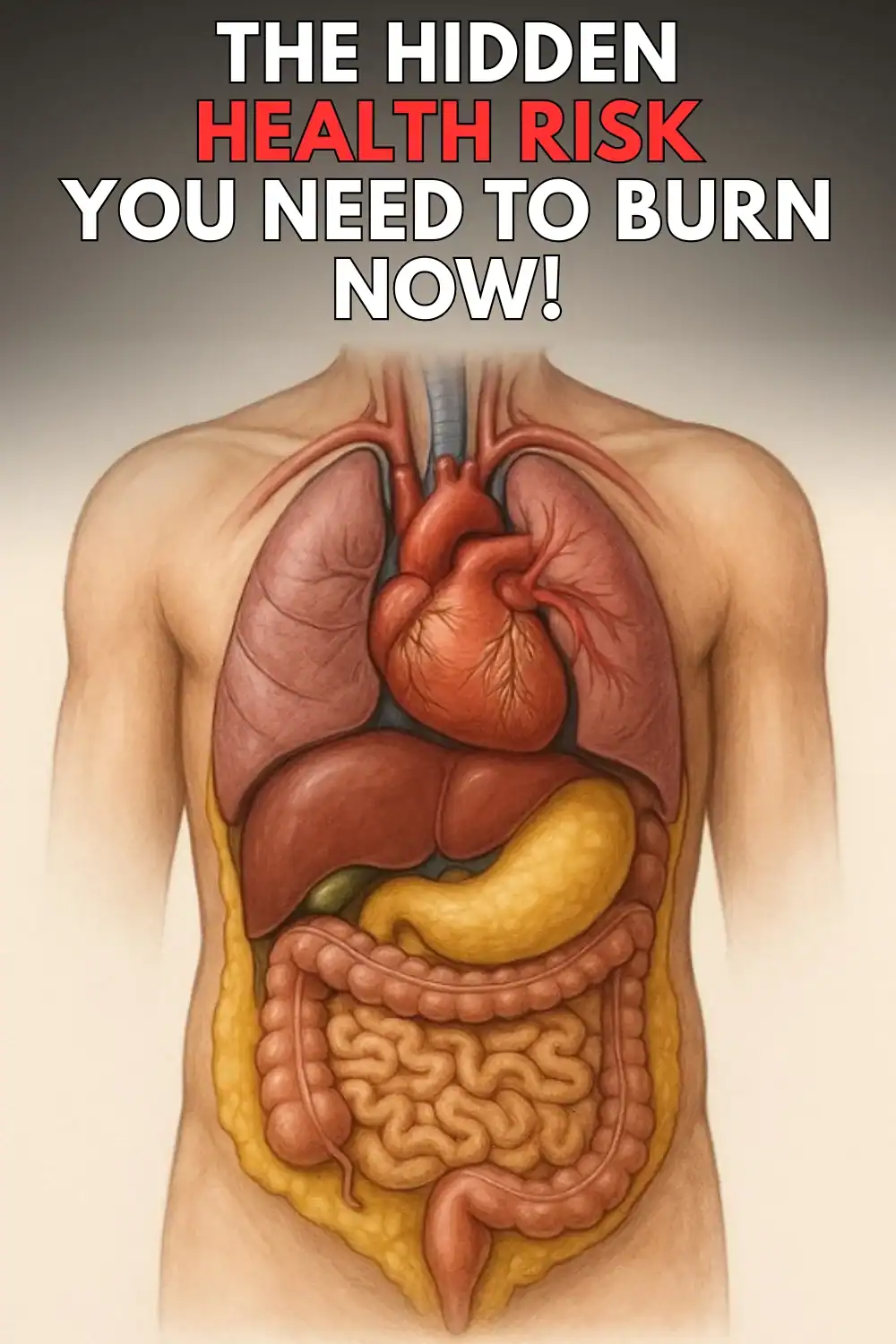The majority of us focus on visible fat accumulation which appears as belly fat, love handles, and weight gain on the scale. But there’s a far more dangerous kind of fat… one that you can’t see or feel.
The medical term for this dangerous type of fat is visceral fat. This type of fat exists deep inside your abdomen as it encircles your vital organs including the liver, pancreas, and intestines. The internal operation of visceral fat differs from subcutaneous fat since it functions quietly yet persistently to disturb bodily functions.
Even more surprising? The condition exists even among individuals who do not show signs of weight gain.
Slim-looking individuals often carry high amounts of visceral fat without any visible signs.
Scientific researchers now label this condition TOFI because it stands for “Thin Outside Fat Inside.”
The article explains visceral fat definition together with its impact on your body and shows how you can naturally defeat it effectively.
1. What Is Visceral Fat?
Not all body fat is created equal.
Most people visualize body fat as the soft layer which lies directly under the skin known as subcutaneous fat yet this type of fat presents minimal health risks. Your body contains a type of fat called visceral fat that exists deep within your internal space yet remains invisible and untouchable.
Visceral fat encircles your internal organs particularly your liver, pancreas, intestines, and kidneys. The abdominal space contains this fat which operates more actively metabolically than subcutaneous fat while producing more aggressive disturbances to your body systems.
Harvard Medical School describes visceral fat as a biologically active substance which produces hormones and inflammatory substances that modify blood pressure, cholesterol, insulin sensitivity and appetite regulation.

The accumulation of excessive visceral fat leads to multiple severe medical conditions that will develop throughout time.
- Type 2 diabetes
- Cardiovascular disease
- Non-alcoholic fatty liver disease
- Stroke
- Hormonal imbalances
- Certain cancers
Unlike subcutaneous fat, which tends to sit quietly under the skin, visceral fat is constantly sending inflammatory signals throughout the body. Outside appearance does not shield you from damage because these signals break down blood vessel structures and disrupt hormonal operations within lean individuals.
The worst part? Visceral fat accumulation occurs within your body even though you show no external signs which makes it essential to learn about its reduction methods for maintaining long-term health.
2. Health Risks of Visceral Fat
Your body operates under active disruption from visceral fat that exists inside your belly region. The dangerous nature of visceral fat exists because it generates hormones, cytokines, and inflammatory substances that spread across your body to silently increase your risk of chronic diseases.
Heart Disease
The existence of visceral fat strongly enhances your chance of developing heart disease. Your body releases chemical compounds that cause LDL cholesterol levels to rise (the “bad” cholesterol) and blood pressure to increase while simultaneously lowering HDL cholesterol levels (the ”good” cholesterol). The combination of these changes leads to arterial plaque formation which increases the likelihood of heart attack and stroke.
Research conducted by the Journal of the American College of Cardiology demonstrated that people with higher visceral fat content had an elevated risk of coronary artery disease after controlling for body mass index.
Type 2 Diabetes
The pancreas and liver which control blood sugar regulation become surrounded by visceral fat. The accumulation of fat in the body disrupts insulin signaling pathways which results in insulin resistance which leads to type 2 diabetes. The National Institutes of Health research shows that visceral fat serves as a better predictor for insulin resistance than waist size measurements or BMI calculations.
The presence of visceral fat raises blood pressure and systemic inflammation which makes you more likely to have a stroke. Study demonstrated that individuals with greater visceral fat had higher chances of developing silent strokes that increase dementia probability.
Hormonal Imbalance
The human body treats visceral fat like an organ that produces hormones. Your body produces higher amounts of stress hormone cortisol and estrogen due to visceral fat which disrupts both your metabolism and energy levels as well as mood and reproductive health.
Inflammation and Insulin Resistance
The presence of visceral fat maintains your body in continuous low-grade inflammation which drives insulin resistance while simultaneously weakening your immune system throughout time.
The metabolic effects of visceral fat exceed its cosmetic implications because it disrupts metabolism while causing significant long-term damage to the body.

3. The Scary Truth About TOFI (Thin Outside, Fat Inside)
The reflection in your mirror can give you a false sense of health when your body appears thin. But that’s not always true.
Certain individuals have normal Body Mass Index (BMI) readings while maintaining hazardous amounts of visceral fat which lies deep within internal body regions. The medical term for this condition is TOFI which means “Thin Outside, Fat Inside.”
The exterior appearance of TOFI individuals belies the dangerous levels of internal fat which increase their chances of developing type 2 diabetes, heart disease, metabolic syndrome, and stroke similarly to obese individuals.
The Journal of the American Medical Association (JAMA) published a landmark study which demonstrated that people with normal BMI and high visceral fat had lower survival rates than obese individuals who stored their fat beneath the skin. The appearance of health does not ensure your internal wellness is also healthy.
Why does this happen? BMI doesn’t measure fat distribution. The measurement depends solely on your weight in relation to your height. The measurement does not reveal whether the weight consists of muscle or fat nor does it show where fat accumulates. The better indicators of internal health include waist circumference and waist-to-hip ratio and body composition scans.
Possible Signs You Might Be TOFI:
- You don’t exercise regularly
- You eat mostly processed or high-sugar foods
- You’re frequently tired or foggy
- You have a bloated belly but low overall weight
- You experience blood sugar dips or frequent cravings
The scary part? You can’t see TOFI. TOFI exists without visible signs while it silently causes harm to your health. Learning about its presence enables you to take appropriate action for its removal.

4. How to Target Visceral Fat Naturally
The good news? Lifestyle adjustments lead to significant responses from visceral fat. There is no requirement to pursue extreme dietary restrictions or become an athlete for exercise. Your health will recover internally by following basic daily routines that reduce hidden fat.
The following section presents four evidence-based methods to target visceral fat.
Move With Purpose
Movement at regular intervals stands as one of the most effective methods for decreasing visceral fat.
The combination of thirty to forty-five minutes of brisk walking five days weekly results in decreased visceral fat accumulation while requiring no substantial weight reduction. The Obesity study demonstrated that moderate-intensity aerobic exercise resulted in a 12% reduction of visceral fat without requiring any dietary changes.
Your body builds muscle through strength training which increases resting metabolism, improves insulin sensitivity, and reduces belly fat.
Strolling for 15 minutes following meals demonstrates ability to stabilize blood sugar while enhancing digestion and minimizing fat accumulation in the body.
Tip: You don’t need intense workouts. Simple routines such as walking while lifting light objects or doing bodyweight exercises at home generate substantial results.
Prioritize Deep Sleep
Sleep is more than rest because it serves as a restoration process. Poor sleep triggers an increase in cortisol (stress hormone) that makes your body store fat deposits near organs.
Research shows people who sleep less than 6 hours per night possess substantially higher levels of visceral fat than those who get 7–9 hours.
Tip: You should establish a relaxing evening schedule. Turn off the lights and stay away from screens as you establish regular sleeping patterns and waking times for every day of the week.

Manage Daily Stress
Chronic stress activates survival mode in your body which leads to fat accumulation primarily in your abdominal area.
Research shows elevated cortisol levels directly contribute to visceral fat accumulation in female bodies.
Use the following three simple stress-reducing techniques throughout your day:
- 5–10 minutes of deep breathing or meditation
- Nature time and green space exploration should be a part of your daily routine
- Yoga alongside tai chi and stretching exercises provide light body movements for relaxation
Even a quiet cup of tea in the sun can reset your stress response.
Support with Smart Supplements
Supplements function as helpful tools when properly used but should never be considered a substitute for actual work.
- Omega-3 fatty acids derived from fish oil or algae have two benefits for the body: they reduce inflammation while improving metabolic health. Meta-analytical results show omega-3 fatty acids effectively minimize waist circumference and visceral fat.
- The green tea extract compound EGCG demonstrates research-backed fat-burning and metabolic-enhancing properties when tested on belly fat subjects.
- Probiotics modify gut bacteria populations which determines how fat accumulates and influences both hunger regulation and emotional states. Certain bacterial strains such as Lactobacillus gasseri demonstrate evidence of abdominal fat reduction in scientific studies.
Tip: Before taking any supplements you should seek medical advice particularly if you have medications.
The fight against visceral fat requires no perfection but rather building sustainable small habits which protect your health throughout time.
5. You Don’t Need to Be Perfect, Just Consistent
The main goal is to improve health rather than achieving unattainable body goals or obtaining a six-pack. The main objective of this approach is to safeguard your vital health mechanisms that truly matter. Although visceral fat stays concealed beneath the surface its harmful impacts remain substantial while minimal consistent actions will reverse its development.
Scientific research demonstrates that moderate changes in lifestyle through walking regularly, better sleep. and stress reduction lead to noticeable visceral fat reduction without needing substantial weight loss. A study published in Obesity demonstrated that losing 5% of body weight produced substantial reductions in both visceral fat and improved insulin sensitivity.
You don’t need to overhaul your entire life. A 10-minute walk after meals. Turning off screens 30 minutes before bed. Swapping soda for green tea. Basic daily practices lead to cumulative benefits that remain achievable.
Think of it like compound interest for your health. A little each day goes a long way. This strategy produces enduring results because it differs from temporary diet fads and short-term weight loss schemes.
You Can’t See Visceral Fat, But You Can Fight It
Visceral fat resides deep inside your body yet produces noticeable harm that extends beyond visibility. The condition exists as a silent threat to your health despite your normal weight appearance. You hold the power to control your health status.
Regular movement combined with high-quality sleep, proper nutrition, and stress management enables you to reduce your visceral fat and safeguard your internal organs. Small daily steps combined with dedication will lead you to your health goals without needing perfection.
The health of your body exists beyond how you look in the mirror. It’s about how you feel, function, and thrive.
One healthy choice each day marks the beginning of your journey.